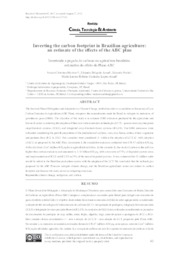Inverting the carbon footprint in Brazilian agriculture: an estimate of the effects of the ABC plan.
Inverting the carbon footprint in Brazilian agriculture: an estimate of the effects of the ABC plan.
Author(s): MARTINS, S. C.; ASSAD, E. D.; PAVÃO, E.; LOPES-ASSAD, M. L. R. C.
Summary: The Sectoral Plan of Mitigation and Adaptation to Climate Change, drafted in order to consolidate an Economy of Low Carbon Emission in Agriculture (ABC Plan), integrates the commitments made by Brazil to mitigate its emissions of greenhouse gases (GHG). The objective of this study is to estimate GHG emissions produced by the agriculture and livestock sector considering the adoption of three low carbon emission technologies (LCT) ? pasture recovery, integrated crop-livestock systems (ICLS), and integrated crop-livestock-forest systems (ICLFS). The GHG emissions were estimated considering the growth projections of the production of soybean, corn, rice, beans, cotton, wheat, sugarcane and pastures from 2012 to 2023. Two scenarios were considered: I - without the adoption of LCT; II - with adoption of LCT, as proposed by the ABC Plan. In scenario I, the cumulative emissions estimated were 670.47 million tCO2eq, with only about 22.67 million tCO2eq from agricultural activities. In the scenario II, the stock of carbon in the soil was higher than carbon emissions and amounted to 1.10 billion tCO2eq, with a recovery of 75% of degraded pasture areas and implementation of ICLS and ICLFS in 25% of the area of degraded pastures. It was estimated that 52 million cattle would be added to the Brazilian production system with the adoption of the LCT. We concluded that the technologies proposed by the ABC Plan can mitigate climate change, and the Brazilian agricultural sector can reduce its carbon footprint and become the main sector in mitigating emissions.
Publication year: 2018
Types of publication: Journal article
Observation
Some of Embrapa's publications are published as ePub files. To read them, use or download one of the following free software options to your computer or mobile device. Android: Google Play Books; IOS: iBooks; Windows and Linux: Calibre.
Access other publications
Access the Agricultural Research Database (BDPA) to consult Embrapa's full library collection and records.
Visit Embrapa Bookstore to purchase books and other publications sold by Embrapa.

